HR and Management Development Analysis
VerifiedAdded on 2020/10/22
|16
|4583
|437
AI Summary
The assignment provides a detailed analysis of HR and management development, focusing on the significance of HR competencies in achieving organizational objectives. It examines the interconnectivity links between competencies and activities, emphasizing the importance of professionalism and work ethics. The document also discusses the effectiveness of CPD (Continuing Professional Development) in improving employee relations and supporting strategy development.
Contribute Materials
Your contribution can guide someone’s learning journey. Share your
documents today.
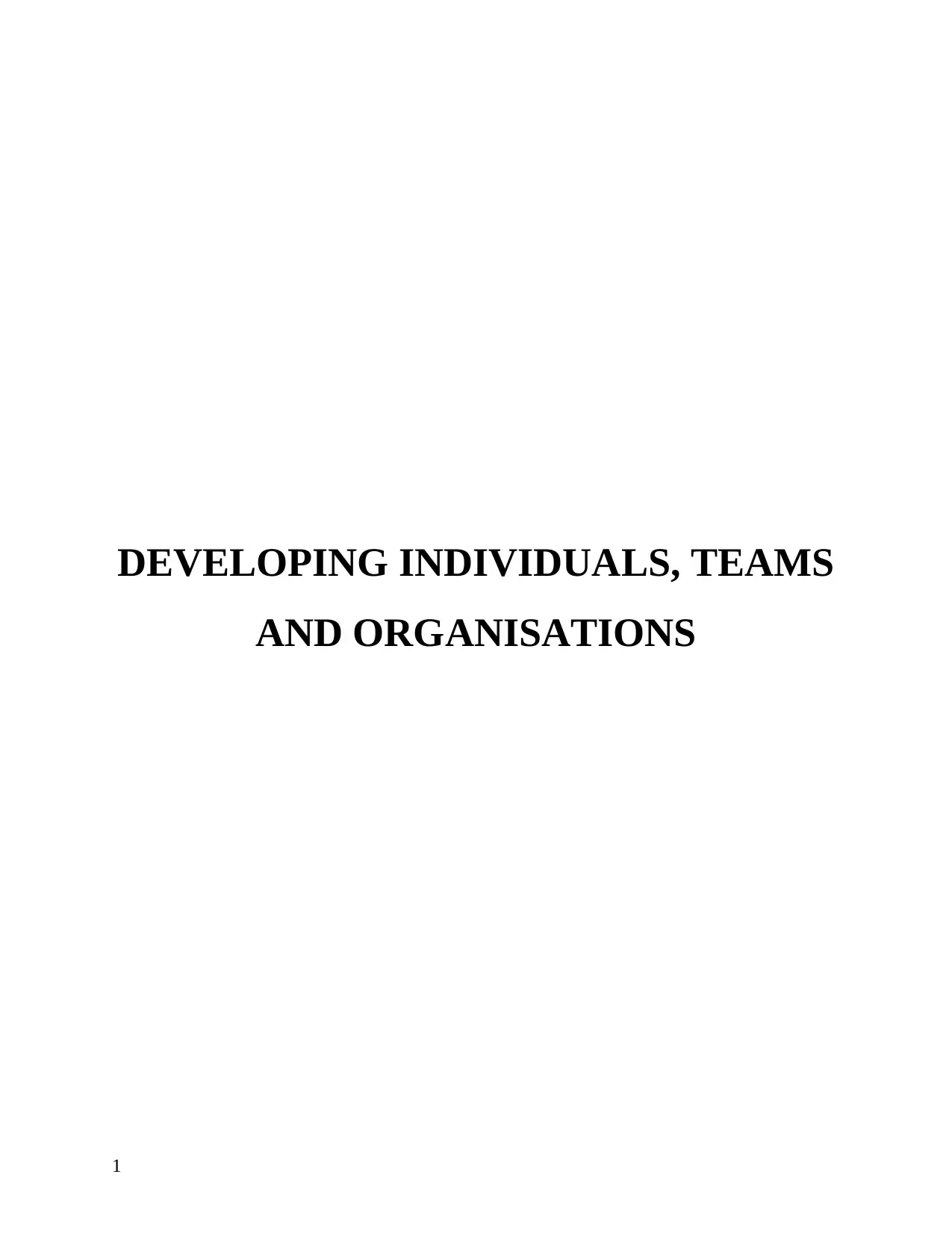
DEVELOPING INDIVIDUALS, TEAMS
AND ORGANISATIONS
1
AND ORGANISATIONS
1
Secure Best Marks with AI Grader
Need help grading? Try our AI Grader for instant feedback on your assignments.
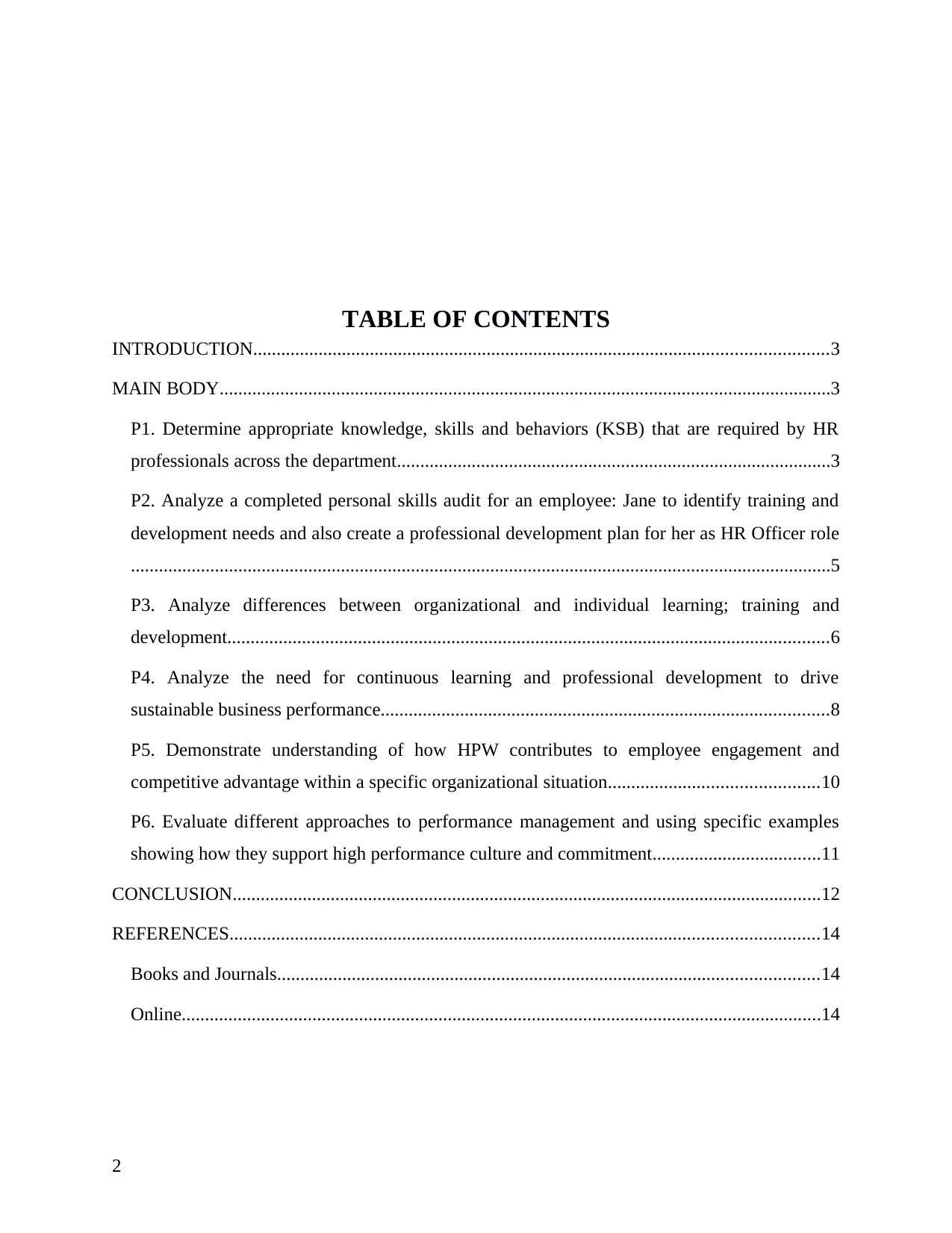
TABLE OF CONTENTS
INTRODUCTION...........................................................................................................................3
MAIN BODY...................................................................................................................................3
P1. Determine appropriate knowledge, skills and behaviors (KSB) that are required by HR
professionals across the department.............................................................................................3
P2. Analyze a completed personal skills audit for an employee: Jane to identify training and
development needs and also create a professional development plan for her as HR Officer role
......................................................................................................................................................5
P3. Analyze differences between organizational and individual learning; training and
development.................................................................................................................................6
P4. Analyze the need for continuous learning and professional development to drive
sustainable business performance................................................................................................8
P5. Demonstrate understanding of how HPW contributes to employee engagement and
competitive advantage within a specific organizational situation.............................................10
P6. Evaluate different approaches to performance management and using specific examples
showing how they support high performance culture and commitment....................................11
CONCLUSION..............................................................................................................................12
REFERENCES..............................................................................................................................14
Books and Journals....................................................................................................................14
Online.........................................................................................................................................14
2
INTRODUCTION...........................................................................................................................3
MAIN BODY...................................................................................................................................3
P1. Determine appropriate knowledge, skills and behaviors (KSB) that are required by HR
professionals across the department.............................................................................................3
P2. Analyze a completed personal skills audit for an employee: Jane to identify training and
development needs and also create a professional development plan for her as HR Officer role
......................................................................................................................................................5
P3. Analyze differences between organizational and individual learning; training and
development.................................................................................................................................6
P4. Analyze the need for continuous learning and professional development to drive
sustainable business performance................................................................................................8
P5. Demonstrate understanding of how HPW contributes to employee engagement and
competitive advantage within a specific organizational situation.............................................10
P6. Evaluate different approaches to performance management and using specific examples
showing how they support high performance culture and commitment....................................11
CONCLUSION..............................................................................................................................12
REFERENCES..............................................................................................................................14
Books and Journals....................................................................................................................14
Online.........................................................................................................................................14
2
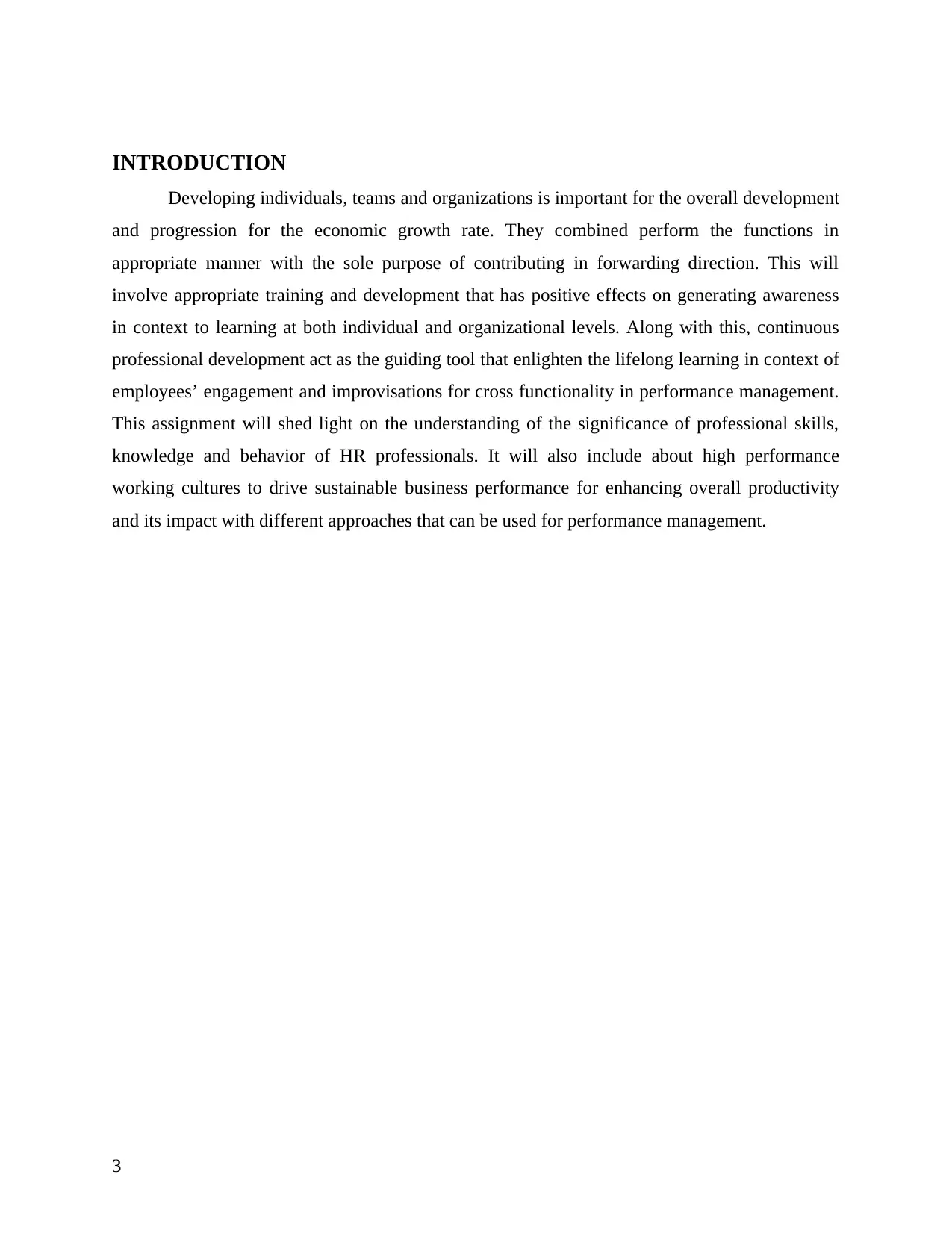
INTRODUCTION
Developing individuals, teams and organizations is important for the overall development
and progression for the economic growth rate. They combined perform the functions in
appropriate manner with the sole purpose of contributing in forwarding direction. This will
involve appropriate training and development that has positive effects on generating awareness
in context to learning at both individual and organizational levels. Along with this, continuous
professional development act as the guiding tool that enlighten the lifelong learning in context of
employees’ engagement and improvisations for cross functionality in performance management.
This assignment will shed light on the understanding of the significance of professional skills,
knowledge and behavior of HR professionals. It will also include about high performance
working cultures to drive sustainable business performance for enhancing overall productivity
and its impact with different approaches that can be used for performance management.
3
Developing individuals, teams and organizations is important for the overall development
and progression for the economic growth rate. They combined perform the functions in
appropriate manner with the sole purpose of contributing in forwarding direction. This will
involve appropriate training and development that has positive effects on generating awareness
in context to learning at both individual and organizational levels. Along with this, continuous
professional development act as the guiding tool that enlighten the lifelong learning in context of
employees’ engagement and improvisations for cross functionality in performance management.
This assignment will shed light on the understanding of the significance of professional skills,
knowledge and behavior of HR professionals. It will also include about high performance
working cultures to drive sustainable business performance for enhancing overall productivity
and its impact with different approaches that can be used for performance management.
3
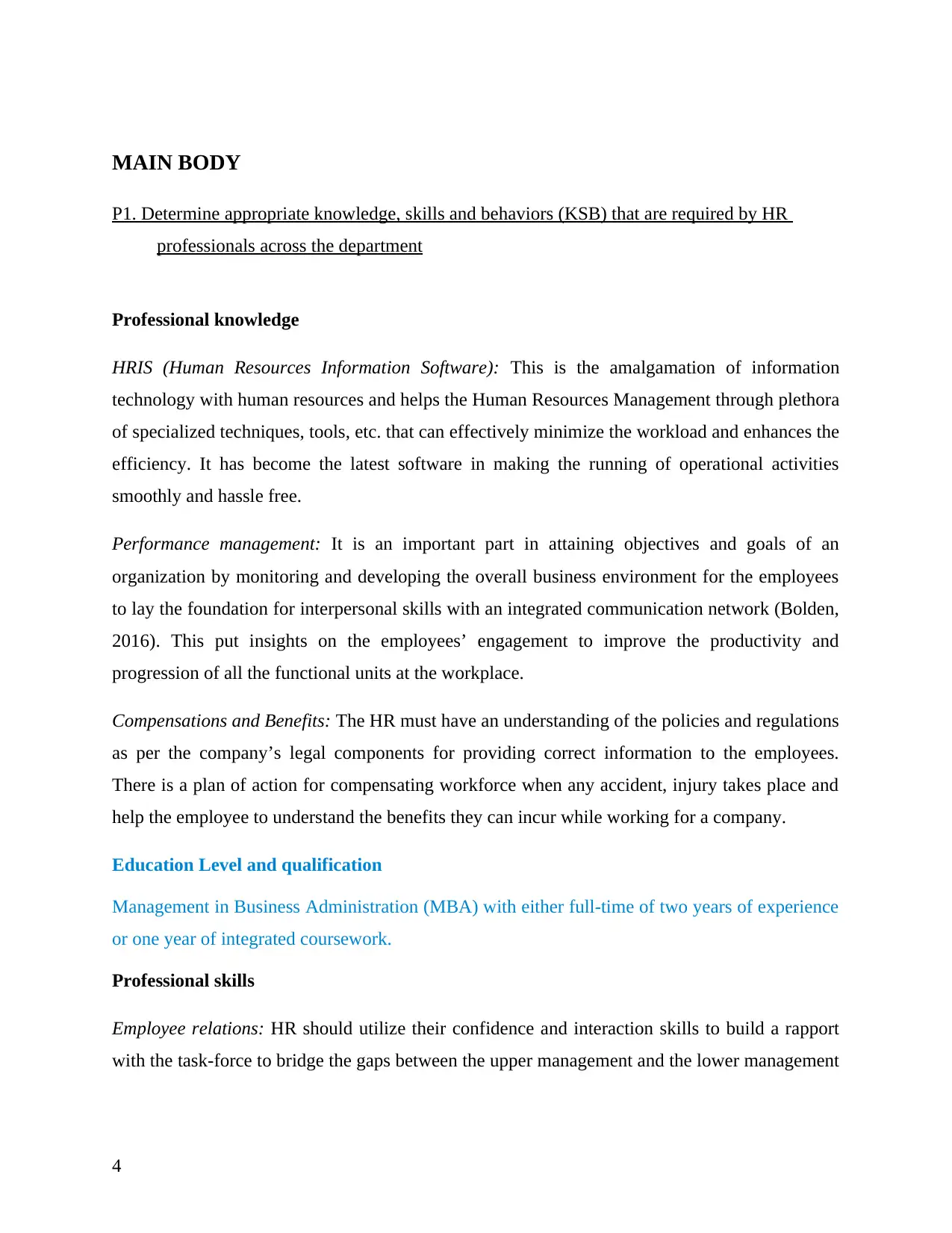
MAIN BODY
P1. Determine appropriate knowledge, skills and behaviors (KSB) that are required by HR
professionals across the department
Professional knowledge
HRIS (Human Resources Information Software): This is the amalgamation of information
technology with human resources and helps the Human Resources Management through plethora
of specialized techniques, tools, etc. that can effectively minimize the workload and enhances the
efficiency. It has become the latest software in making the running of operational activities
smoothly and hassle free.
Performance management: It is an important part in attaining objectives and goals of an
organization by monitoring and developing the overall business environment for the employees
to lay the foundation for interpersonal skills with an integrated communication network (Bolden,
2016). This put insights on the employees’ engagement to improve the productivity and
progression of all the functional units at the workplace.
Compensations and Benefits: The HR must have an understanding of the policies and regulations
as per the company’s legal components for providing correct information to the employees.
There is a plan of action for compensating workforce when any accident, injury takes place and
help the employee to understand the benefits they can incur while working for a company.
Education Level and qualification
Management in Business Administration (MBA) with either full-time of two years of experience
or one year of integrated coursework.
Professional skills
Employee relations: HR should utilize their confidence and interaction skills to build a rapport
with the task-force to bridge the gaps between the upper management and the lower management
4
P1. Determine appropriate knowledge, skills and behaviors (KSB) that are required by HR
professionals across the department
Professional knowledge
HRIS (Human Resources Information Software): This is the amalgamation of information
technology with human resources and helps the Human Resources Management through plethora
of specialized techniques, tools, etc. that can effectively minimize the workload and enhances the
efficiency. It has become the latest software in making the running of operational activities
smoothly and hassle free.
Performance management: It is an important part in attaining objectives and goals of an
organization by monitoring and developing the overall business environment for the employees
to lay the foundation for interpersonal skills with an integrated communication network (Bolden,
2016). This put insights on the employees’ engagement to improve the productivity and
progression of all the functional units at the workplace.
Compensations and Benefits: The HR must have an understanding of the policies and regulations
as per the company’s legal components for providing correct information to the employees.
There is a plan of action for compensating workforce when any accident, injury takes place and
help the employee to understand the benefits they can incur while working for a company.
Education Level and qualification
Management in Business Administration (MBA) with either full-time of two years of experience
or one year of integrated coursework.
Professional skills
Employee relations: HR should utilize their confidence and interaction skills to build a rapport
with the task-force to bridge the gaps between the upper management and the lower management
4
Secure Best Marks with AI Grader
Need help grading? Try our AI Grader for instant feedback on your assignments.
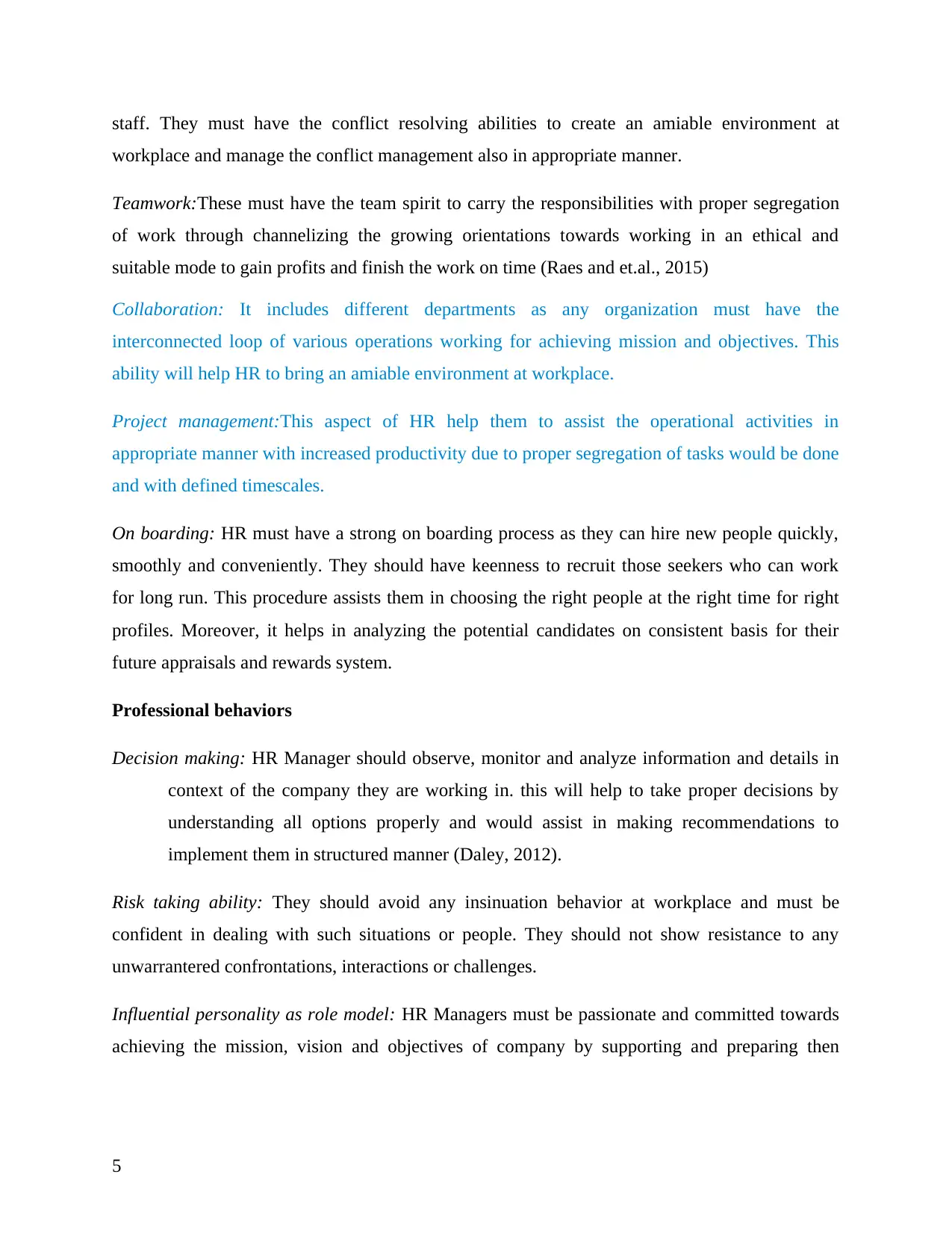
staff. They must have the conflict resolving abilities to create an amiable environment at
workplace and manage the conflict management also in appropriate manner.
Teamwork:These must have the team spirit to carry the responsibilities with proper segregation
of work through channelizing the growing orientations towards working in an ethical and
suitable mode to gain profits and finish the work on time (Raes and et.al., 2015)
Collaboration: It includes different departments as any organization must have the
interconnected loop of various operations working for achieving mission and objectives. This
ability will help HR to bring an amiable environment at workplace.
Project management:This aspect of HR help them to assist the operational activities in
appropriate manner with increased productivity due to proper segregation of tasks would be done
and with defined timescales.
On boarding: HR must have a strong on boarding process as they can hire new people quickly,
smoothly and conveniently. They should have keenness to recruit those seekers who can work
for long run. This procedure assists them in choosing the right people at the right time for right
profiles. Moreover, it helps in analyzing the potential candidates on consistent basis for their
future appraisals and rewards system.
Professional behaviors
Decision making: HR Manager should observe, monitor and analyze information and details in
context of the company they are working in. this will help to take proper decisions by
understanding all options properly and would assist in making recommendations to
implement them in structured manner (Daley, 2012).
Risk taking ability: They should avoid any insinuation behavior at workplace and must be
confident in dealing with such situations or people. They should not show resistance to any
unwarrantered confrontations, interactions or challenges.
Influential personality as role model: HR Managers must be passionate and committed towards
achieving the mission, vision and objectives of company by supporting and preparing then
5
workplace and manage the conflict management also in appropriate manner.
Teamwork:These must have the team spirit to carry the responsibilities with proper segregation
of work through channelizing the growing orientations towards working in an ethical and
suitable mode to gain profits and finish the work on time (Raes and et.al., 2015)
Collaboration: It includes different departments as any organization must have the
interconnected loop of various operations working for achieving mission and objectives. This
ability will help HR to bring an amiable environment at workplace.
Project management:This aspect of HR help them to assist the operational activities in
appropriate manner with increased productivity due to proper segregation of tasks would be done
and with defined timescales.
On boarding: HR must have a strong on boarding process as they can hire new people quickly,
smoothly and conveniently. They should have keenness to recruit those seekers who can work
for long run. This procedure assists them in choosing the right people at the right time for right
profiles. Moreover, it helps in analyzing the potential candidates on consistent basis for their
future appraisals and rewards system.
Professional behaviors
Decision making: HR Manager should observe, monitor and analyze information and details in
context of the company they are working in. this will help to take proper decisions by
understanding all options properly and would assist in making recommendations to
implement them in structured manner (Daley, 2012).
Risk taking ability: They should avoid any insinuation behavior at workplace and must be
confident in dealing with such situations or people. They should not show resistance to any
unwarrantered confrontations, interactions or challenges.
Influential personality as role model: HR Managers must be passionate and committed towards
achieving the mission, vision and objectives of company by supporting and preparing then
5
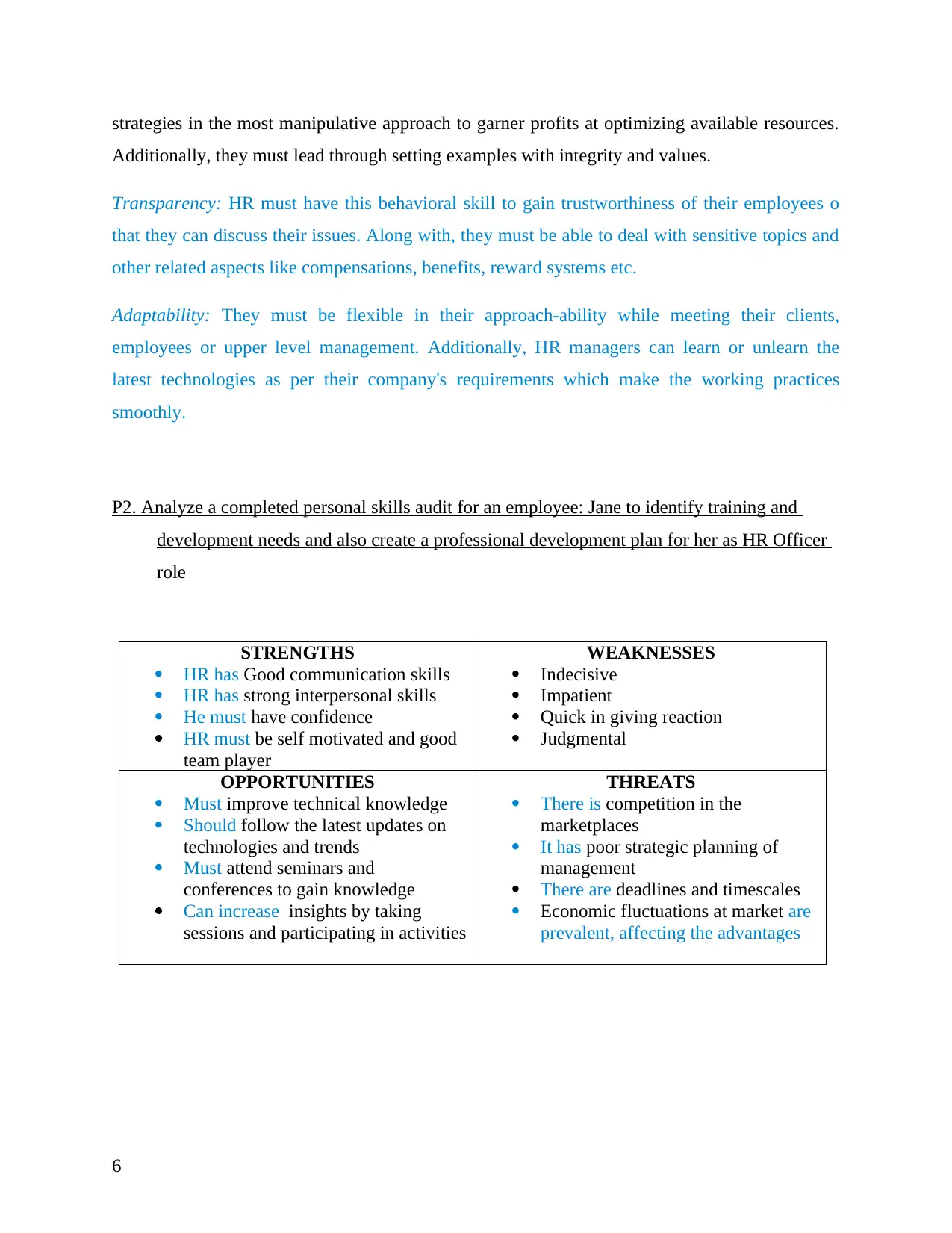
strategies in the most manipulative approach to garner profits at optimizing available resources.
Additionally, they must lead through setting examples with integrity and values.
Transparency: HR must have this behavioral skill to gain trustworthiness of their employees o
that they can discuss their issues. Along with, they must be able to deal with sensitive topics and
other related aspects like compensations, benefits, reward systems etc.
Adaptability: They must be flexible in their approach-ability while meeting their clients,
employees or upper level management. Additionally, HR managers can learn or unlearn the
latest technologies as per their company's requirements which make the working practices
smoothly.
P2. Analyze a completed personal skills audit for an employee: Jane to identify training and
development needs and also create a professional development plan for her as HR Officer
role
STRENGTHS
HR has Good communication skills
HR has strong interpersonal skills
He must have confidence
HR must be self motivated and good
team player
WEAKNESSES
Indecisive
Impatient
Quick in giving reaction
Judgmental
OPPORTUNITIES
Must improve technical knowledge
Should follow the latest updates on
technologies and trends
Must attend seminars and
conferences to gain knowledge
Can increase insights by taking
sessions and participating in activities
THREATS
There is competition in the
marketplaces
It has poor strategic planning of
management
There are deadlines and timescales
Economic fluctuations at market are
prevalent, affecting the advantages
6
Additionally, they must lead through setting examples with integrity and values.
Transparency: HR must have this behavioral skill to gain trustworthiness of their employees o
that they can discuss their issues. Along with, they must be able to deal with sensitive topics and
other related aspects like compensations, benefits, reward systems etc.
Adaptability: They must be flexible in their approach-ability while meeting their clients,
employees or upper level management. Additionally, HR managers can learn or unlearn the
latest technologies as per their company's requirements which make the working practices
smoothly.
P2. Analyze a completed personal skills audit for an employee: Jane to identify training and
development needs and also create a professional development plan for her as HR Officer
role
STRENGTHS
HR has Good communication skills
HR has strong interpersonal skills
He must have confidence
HR must be self motivated and good
team player
WEAKNESSES
Indecisive
Impatient
Quick in giving reaction
Judgmental
OPPORTUNITIES
Must improve technical knowledge
Should follow the latest updates on
technologies and trends
Must attend seminars and
conferences to gain knowledge
Can increase insights by taking
sessions and participating in activities
THREATS
There is competition in the
marketplaces
It has poor strategic planning of
management
There are deadlines and timescales
Economic fluctuations at market are
prevalent, affecting the advantages
6
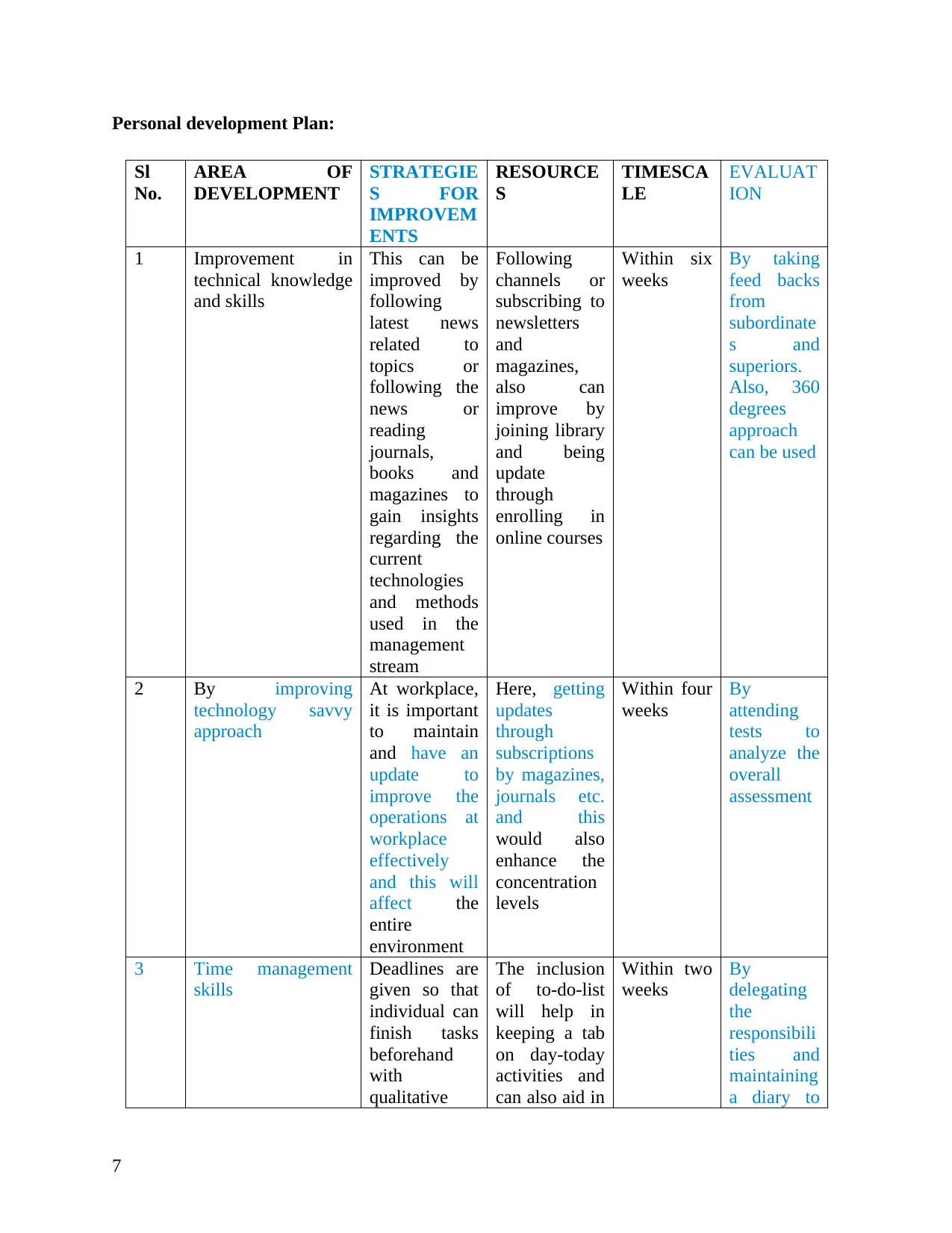
Personal development Plan:
Sl
No.
AREA OF
DEVELOPMENT
STRATEGIE
S FOR
IMPROVEM
ENTS
RESOURCE
S
TIMESCA
LE
EVALUAT
ION
1 Improvement in
technical knowledge
and skills
This can be
improved by
following
latest news
related to
topics or
following the
news or
reading
journals,
books and
magazines to
gain insights
regarding the
current
technologies
and methods
used in the
management
stream
Following
channels or
subscribing to
newsletters
and
magazines,
also can
improve by
joining library
and being
update
through
enrolling in
online courses
Within six
weeks
By taking
feed backs
from
subordinate
s and
superiors.
Also, 360
degrees
approach
can be used
2 By improving
technology savvy
approach
At workplace,
it is important
to maintain
and have an
update to
improve the
operations at
workplace
effectively
and this will
affect the
entire
environment
Here, getting
updates
through
subscriptions
by magazines,
journals etc.
and this
would also
enhance the
concentration
levels
Within four
weeks
By
attending
tests to
analyze the
overall
assessment
3 Time management
skills
Deadlines are
given so that
individual can
finish tasks
beforehand
with
qualitative
The inclusion
of to-do-list
will help in
keeping a tab
on day-today
activities and
can also aid in
Within two
weeks
By
delegating
the
responsibili
ties and
maintaining
a diary to
7
Sl
No.
AREA OF
DEVELOPMENT
STRATEGIE
S FOR
IMPROVEM
ENTS
RESOURCE
S
TIMESCA
LE
EVALUAT
ION
1 Improvement in
technical knowledge
and skills
This can be
improved by
following
latest news
related to
topics or
following the
news or
reading
journals,
books and
magazines to
gain insights
regarding the
current
technologies
and methods
used in the
management
stream
Following
channels or
subscribing to
newsletters
and
magazines,
also can
improve by
joining library
and being
update
through
enrolling in
online courses
Within six
weeks
By taking
feed backs
from
subordinate
s and
superiors.
Also, 360
degrees
approach
can be used
2 By improving
technology savvy
approach
At workplace,
it is important
to maintain
and have an
update to
improve the
operations at
workplace
effectively
and this will
affect the
entire
environment
Here, getting
updates
through
subscriptions
by magazines,
journals etc.
and this
would also
enhance the
concentration
levels
Within four
weeks
By
attending
tests to
analyze the
overall
assessment
3 Time management
skills
Deadlines are
given so that
individual can
finish tasks
beforehand
with
qualitative
The inclusion
of to-do-list
will help in
keeping a tab
on day-today
activities and
can also aid in
Within two
weeks
By
delegating
the
responsibili
ties and
maintaining
a diary to
7
Paraphrase This Document
Need a fresh take? Get an instant paraphrase of this document with our AI Paraphraser
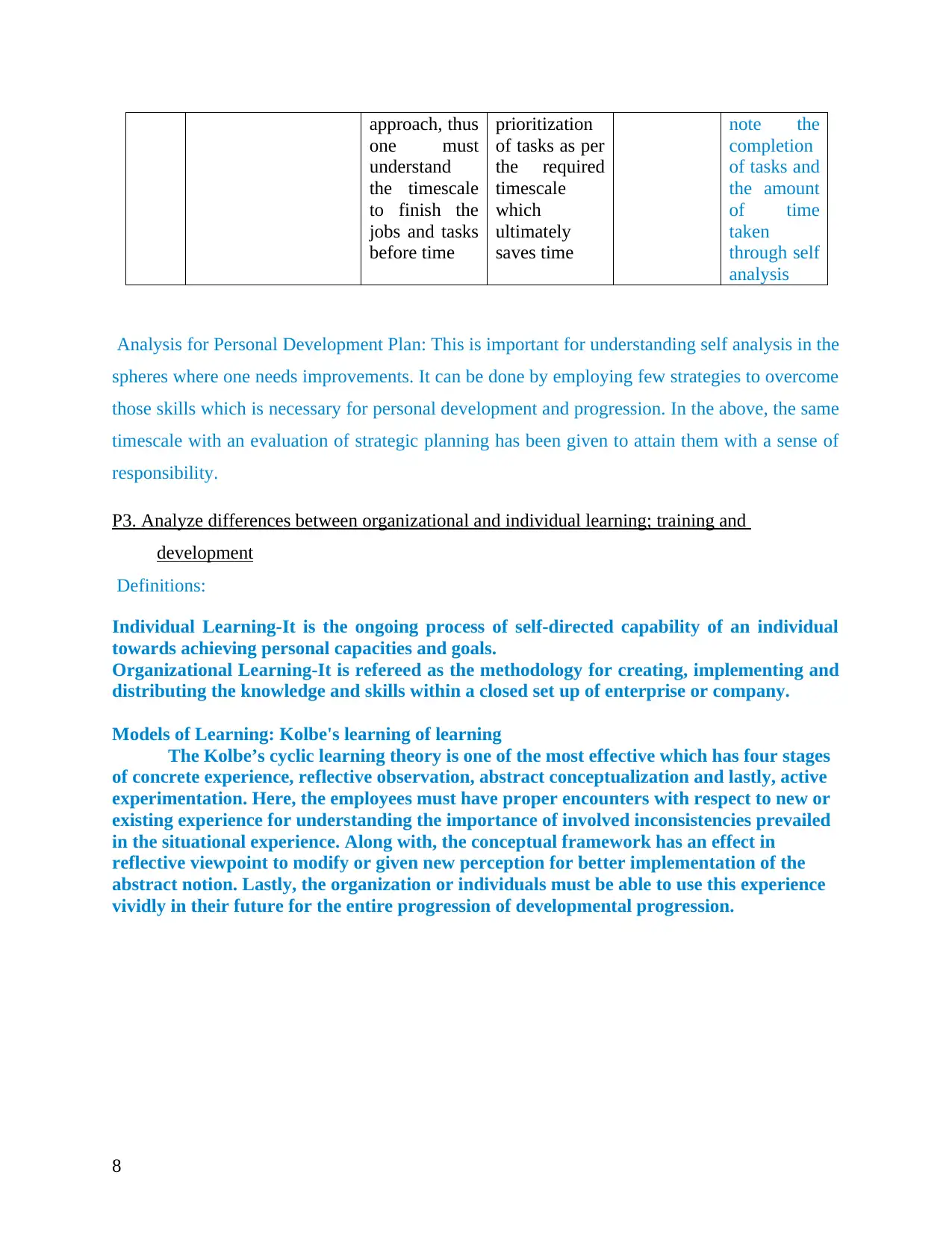
approach, thus
one must
understand
the timescale
to finish the
jobs and tasks
before time
prioritization
of tasks as per
the required
timescale
which
ultimately
saves time
note the
completion
of tasks and
the amount
of time
taken
through self
analysis
Analysis for Personal Development Plan: This is important for understanding self analysis in the
spheres where one needs improvements. It can be done by employing few strategies to overcome
those skills which is necessary for personal development and progression. In the above, the same
timescale with an evaluation of strategic planning has been given to attain them with a sense of
responsibility.
P3. Analyze differences between organizational and individual learning; training and
development
Definitions:
Individual Learning-It is the ongoing process of self-directed capability of an individual
towards achieving personal capacities and goals.
Organizational Learning-It is refereed as the methodology for creating, implementing and
distributing the knowledge and skills within a closed set up of enterprise or company.
Models of Learning: Kolbe's learning of learning
The Kolbe’s cyclic learning theory is one of the most effective which has four stages
of concrete experience, reflective observation, abstract conceptualization and lastly, active
experimentation. Here, the employees must have proper encounters with respect to new or
existing experience for understanding the importance of involved inconsistencies prevailed
in the situational experience. Along with, the conceptual framework has an effect in
reflective viewpoint to modify or given new perception for better implementation of the
abstract notion. Lastly, the organization or individuals must be able to use this experience
vividly in their future for the entire progression of developmental progression.
8
one must
understand
the timescale
to finish the
jobs and tasks
before time
prioritization
of tasks as per
the required
timescale
which
ultimately
saves time
note the
completion
of tasks and
the amount
of time
taken
through self
analysis
Analysis for Personal Development Plan: This is important for understanding self analysis in the
spheres where one needs improvements. It can be done by employing few strategies to overcome
those skills which is necessary for personal development and progression. In the above, the same
timescale with an evaluation of strategic planning has been given to attain them with a sense of
responsibility.
P3. Analyze differences between organizational and individual learning; training and
development
Definitions:
Individual Learning-It is the ongoing process of self-directed capability of an individual
towards achieving personal capacities and goals.
Organizational Learning-It is refereed as the methodology for creating, implementing and
distributing the knowledge and skills within a closed set up of enterprise or company.
Models of Learning: Kolbe's learning of learning
The Kolbe’s cyclic learning theory is one of the most effective which has four stages
of concrete experience, reflective observation, abstract conceptualization and lastly, active
experimentation. Here, the employees must have proper encounters with respect to new or
existing experience for understanding the importance of involved inconsistencies prevailed
in the situational experience. Along with, the conceptual framework has an effect in
reflective viewpoint to modify or given new perception for better implementation of the
abstract notion. Lastly, the organization or individuals must be able to use this experience
vividly in their future for the entire progression of developmental progression.
8
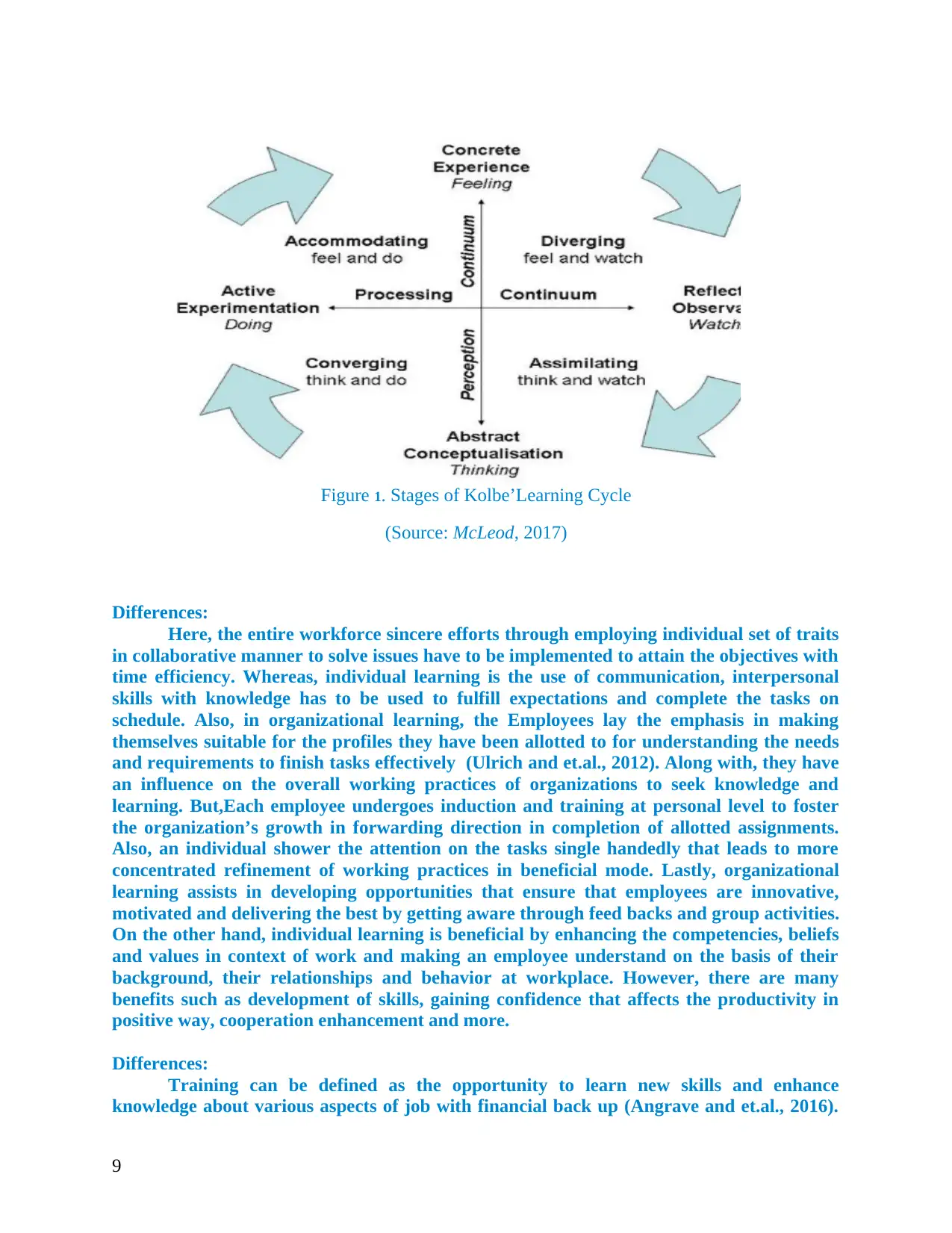
Figure 1. Stages of Kolbe’Learning Cycle
(Source: McLeod, 2017)
Differences:
Here, the entire workforce sincere efforts through employing individual set of traits
in collaborative manner to solve issues have to be implemented to attain the objectives with
time efficiency. Whereas, individual learning is the use of communication, interpersonal
skills with knowledge has to be used to fulfill expectations and complete the tasks on
schedule. Also, in organizational learning, the Employees lay the emphasis in making
themselves suitable for the profiles they have been allotted to for understanding the needs
and requirements to finish tasks effectively (Ulrich and et.al., 2012). Along with, they have
an influence on the overall working practices of organizations to seek knowledge and
learning. But,Each employee undergoes induction and training at personal level to foster
the organization’s growth in forwarding direction in completion of allotted assignments.
Also, an individual shower the attention on the tasks single handedly that leads to more
concentrated refinement of working practices in beneficial mode. Lastly, organizational
learning assists in developing opportunities that ensure that employees are innovative,
motivated and delivering the best by getting aware through feed backs and group activities.
On the other hand, individual learning is beneficial by enhancing the competencies, beliefs
and values in context of work and making an employee understand on the basis of their
background, their relationships and behavior at workplace. However, there are many
benefits such as development of skills, gaining confidence that affects the productivity in
positive way, cooperation enhancement and more.
Differences:
Training can be defined as the opportunity to learn new skills and enhance
knowledge about various aspects of job with financial back up (Angrave and et.al., 2016).
9
(Source: McLeod, 2017)
Differences:
Here, the entire workforce sincere efforts through employing individual set of traits
in collaborative manner to solve issues have to be implemented to attain the objectives with
time efficiency. Whereas, individual learning is the use of communication, interpersonal
skills with knowledge has to be used to fulfill expectations and complete the tasks on
schedule. Also, in organizational learning, the Employees lay the emphasis in making
themselves suitable for the profiles they have been allotted to for understanding the needs
and requirements to finish tasks effectively (Ulrich and et.al., 2012). Along with, they have
an influence on the overall working practices of organizations to seek knowledge and
learning. But,Each employee undergoes induction and training at personal level to foster
the organization’s growth in forwarding direction in completion of allotted assignments.
Also, an individual shower the attention on the tasks single handedly that leads to more
concentrated refinement of working practices in beneficial mode. Lastly, organizational
learning assists in developing opportunities that ensure that employees are innovative,
motivated and delivering the best by getting aware through feed backs and group activities.
On the other hand, individual learning is beneficial by enhancing the competencies, beliefs
and values in context of work and making an employee understand on the basis of their
background, their relationships and behavior at workplace. However, there are many
benefits such as development of skills, gaining confidence that affects the productivity in
positive way, cooperation enhancement and more.
Differences:
Training can be defined as the opportunity to learn new skills and enhance
knowledge about various aspects of job with financial back up (Angrave and et.al., 2016).
9
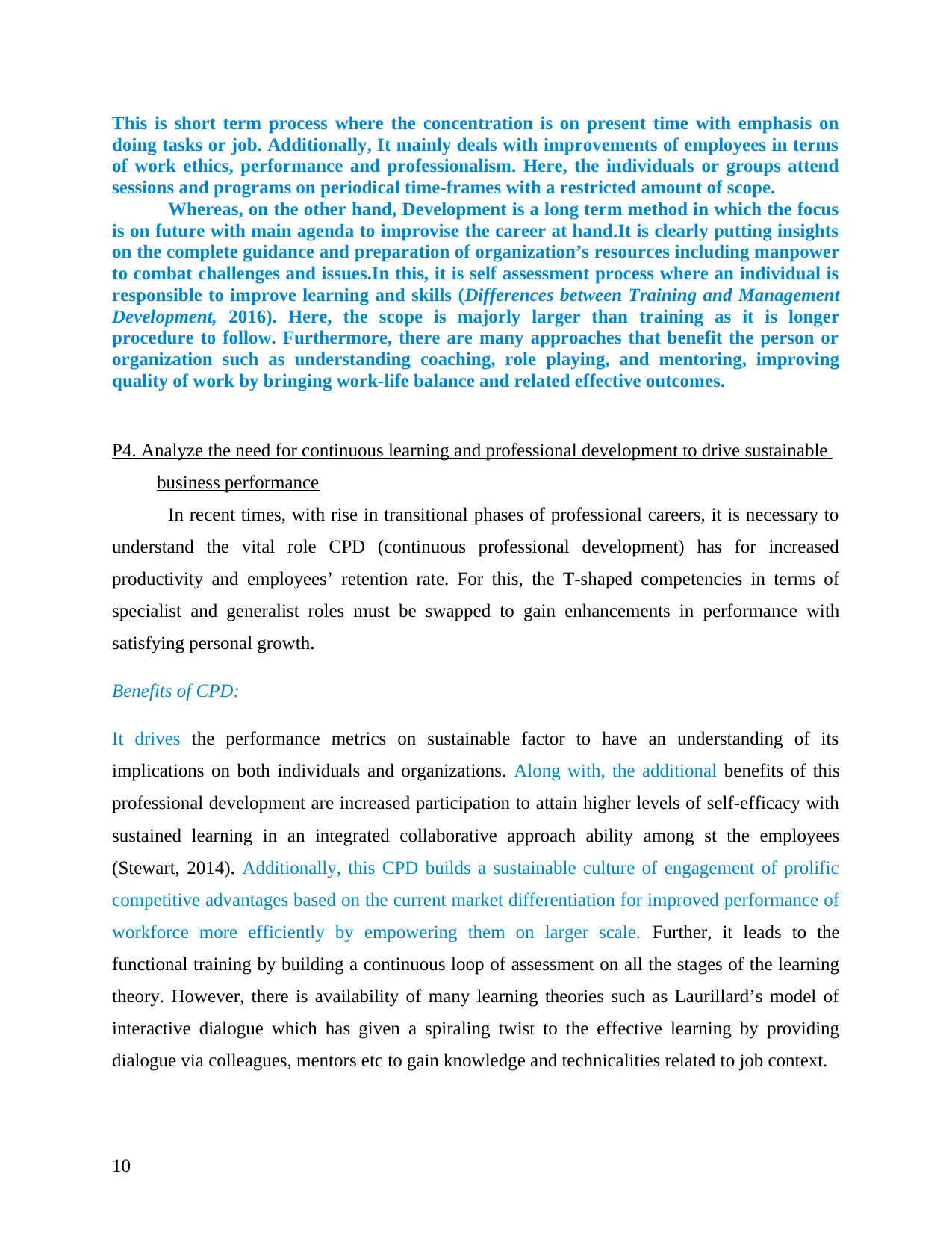
This is short term process where the concentration is on present time with emphasis on
doing tasks or job. Additionally, It mainly deals with improvements of employees in terms
of work ethics, performance and professionalism. Here, the individuals or groups attend
sessions and programs on periodical time-frames with a restricted amount of scope.
Whereas, on the other hand, Development is a long term method in which the focus
is on future with main agenda to improvise the career at hand.It is clearly putting insights
on the complete guidance and preparation of organization’s resources including manpower
to combat challenges and issues.In this, it is self assessment process where an individual is
responsible to improve learning and skills (Differences between Training and Management
Development, 2016). Here, the scope is majorly larger than training as it is longer
procedure to follow. Furthermore, there are many approaches that benefit the person or
organization such as understanding coaching, role playing, and mentoring, improving
quality of work by bringing work-life balance and related effective outcomes.
P4. Analyze the need for continuous learning and professional development to drive sustainable
business performance
In recent times, with rise in transitional phases of professional careers, it is necessary to
understand the vital role CPD (continuous professional development) has for increased
productivity and employees’ retention rate. For this, the T-shaped competencies in terms of
specialist and generalist roles must be swapped to gain enhancements in performance with
satisfying personal growth.
Benefits of CPD:
It drives the performance metrics on sustainable factor to have an understanding of its
implications on both individuals and organizations. Along with, the additional benefits of this
professional development are increased participation to attain higher levels of self-efficacy with
sustained learning in an integrated collaborative approach ability among st the employees
(Stewart, 2014). Additionally, this CPD builds a sustainable culture of engagement of prolific
competitive advantages based on the current market differentiation for improved performance of
workforce more efficiently by empowering them on larger scale. Further, it leads to the
functional training by building a continuous loop of assessment on all the stages of the learning
theory. However, there is availability of many learning theories such as Laurillard’s model of
interactive dialogue which has given a spiraling twist to the effective learning by providing
dialogue via colleagues, mentors etc to gain knowledge and technicalities related to job context.
10
doing tasks or job. Additionally, It mainly deals with improvements of employees in terms
of work ethics, performance and professionalism. Here, the individuals or groups attend
sessions and programs on periodical time-frames with a restricted amount of scope.
Whereas, on the other hand, Development is a long term method in which the focus
is on future with main agenda to improvise the career at hand.It is clearly putting insights
on the complete guidance and preparation of organization’s resources including manpower
to combat challenges and issues.In this, it is self assessment process where an individual is
responsible to improve learning and skills (Differences between Training and Management
Development, 2016). Here, the scope is majorly larger than training as it is longer
procedure to follow. Furthermore, there are many approaches that benefit the person or
organization such as understanding coaching, role playing, and mentoring, improving
quality of work by bringing work-life balance and related effective outcomes.
P4. Analyze the need for continuous learning and professional development to drive sustainable
business performance
In recent times, with rise in transitional phases of professional careers, it is necessary to
understand the vital role CPD (continuous professional development) has for increased
productivity and employees’ retention rate. For this, the T-shaped competencies in terms of
specialist and generalist roles must be swapped to gain enhancements in performance with
satisfying personal growth.
Benefits of CPD:
It drives the performance metrics on sustainable factor to have an understanding of its
implications on both individuals and organizations. Along with, the additional benefits of this
professional development are increased participation to attain higher levels of self-efficacy with
sustained learning in an integrated collaborative approach ability among st the employees
(Stewart, 2014). Additionally, this CPD builds a sustainable culture of engagement of prolific
competitive advantages based on the current market differentiation for improved performance of
workforce more efficiently by empowering them on larger scale. Further, it leads to the
functional training by building a continuous loop of assessment on all the stages of the learning
theory. However, there is availability of many learning theories such as Laurillard’s model of
interactive dialogue which has given a spiraling twist to the effective learning by providing
dialogue via colleagues, mentors etc to gain knowledge and technicalities related to job context.
10
Secure Best Marks with AI Grader
Need help grading? Try our AI Grader for instant feedback on your assignments.
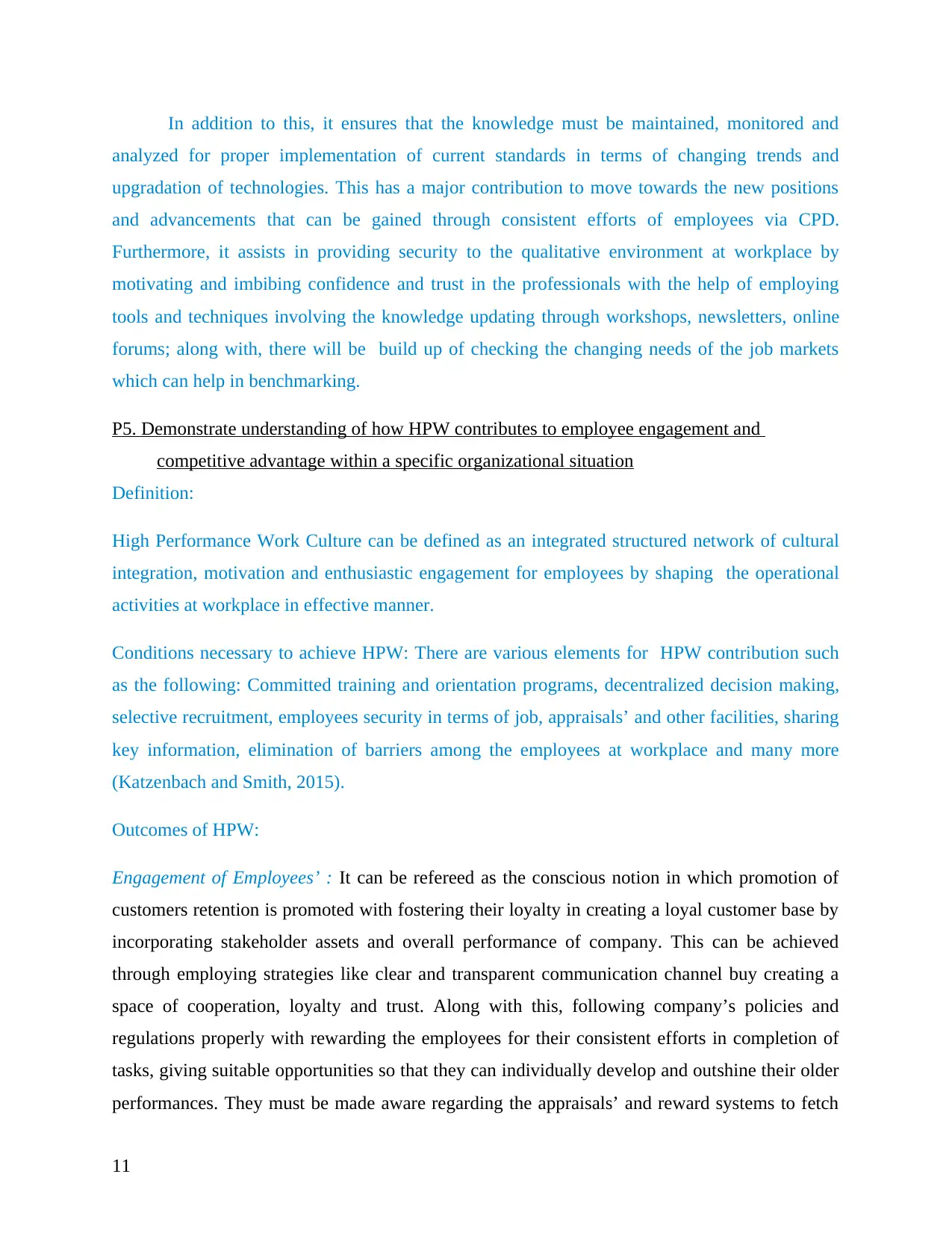
In addition to this, it ensures that the knowledge must be maintained, monitored and
analyzed for proper implementation of current standards in terms of changing trends and
upgradation of technologies. This has a major contribution to move towards the new positions
and advancements that can be gained through consistent efforts of employees via CPD.
Furthermore, it assists in providing security to the qualitative environment at workplace by
motivating and imbibing confidence and trust in the professionals with the help of employing
tools and techniques involving the knowledge updating through workshops, newsletters, online
forums; along with, there will be build up of checking the changing needs of the job markets
which can help in benchmarking.
P5. Demonstrate understanding of how HPW contributes to employee engagement and
competitive advantage within a specific organizational situation
Definition:
High Performance Work Culture can be defined as an integrated structured network of cultural
integration, motivation and enthusiastic engagement for employees by shaping the operational
activities at workplace in effective manner.
Conditions necessary to achieve HPW: There are various elements for HPW contribution such
as the following: Committed training and orientation programs, decentralized decision making,
selective recruitment, employees security in terms of job, appraisals’ and other facilities, sharing
key information, elimination of barriers among the employees at workplace and many more
(Katzenbach and Smith, 2015).
Outcomes of HPW:
Engagement of Employees’ : It can be refereed as the conscious notion in which promotion of
customers retention is promoted with fostering their loyalty in creating a loyal customer base by
incorporating stakeholder assets and overall performance of company. This can be achieved
through employing strategies like clear and transparent communication channel buy creating a
space of cooperation, loyalty and trust. Along with this, following company’s policies and
regulations properly with rewarding the employees for their consistent efforts in completion of
tasks, giving suitable opportunities so that they can individually develop and outshine their older
performances. They must be made aware regarding the appraisals’ and reward systems to fetch
11
analyzed for proper implementation of current standards in terms of changing trends and
upgradation of technologies. This has a major contribution to move towards the new positions
and advancements that can be gained through consistent efforts of employees via CPD.
Furthermore, it assists in providing security to the qualitative environment at workplace by
motivating and imbibing confidence and trust in the professionals with the help of employing
tools and techniques involving the knowledge updating through workshops, newsletters, online
forums; along with, there will be build up of checking the changing needs of the job markets
which can help in benchmarking.
P5. Demonstrate understanding of how HPW contributes to employee engagement and
competitive advantage within a specific organizational situation
Definition:
High Performance Work Culture can be defined as an integrated structured network of cultural
integration, motivation and enthusiastic engagement for employees by shaping the operational
activities at workplace in effective manner.
Conditions necessary to achieve HPW: There are various elements for HPW contribution such
as the following: Committed training and orientation programs, decentralized decision making,
selective recruitment, employees security in terms of job, appraisals’ and other facilities, sharing
key information, elimination of barriers among the employees at workplace and many more
(Katzenbach and Smith, 2015).
Outcomes of HPW:
Engagement of Employees’ : It can be refereed as the conscious notion in which promotion of
customers retention is promoted with fostering their loyalty in creating a loyal customer base by
incorporating stakeholder assets and overall performance of company. This can be achieved
through employing strategies like clear and transparent communication channel buy creating a
space of cooperation, loyalty and trust. Along with this, following company’s policies and
regulations properly with rewarding the employees for their consistent efforts in completion of
tasks, giving suitable opportunities so that they can individually develop and outshine their older
performances. They must be made aware regarding the appraisals’ and reward systems to fetch
11
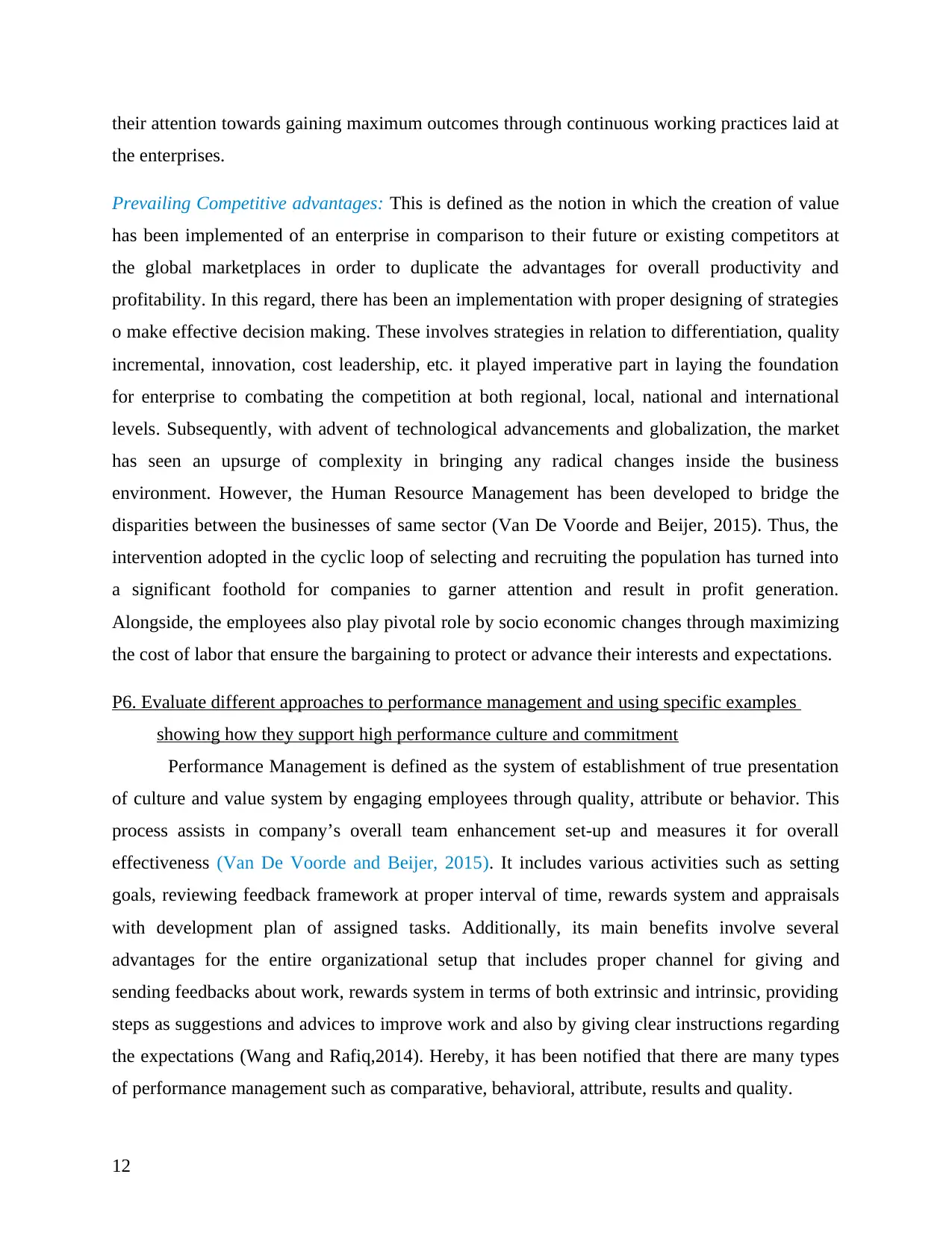
their attention towards gaining maximum outcomes through continuous working practices laid at
the enterprises.
Prevailing Competitive advantages: This is defined as the notion in which the creation of value
has been implemented of an enterprise in comparison to their future or existing competitors at
the global marketplaces in order to duplicate the advantages for overall productivity and
profitability. In this regard, there has been an implementation with proper designing of strategies
o make effective decision making. These involves strategies in relation to differentiation, quality
incremental, innovation, cost leadership, etc. it played imperative part in laying the foundation
for enterprise to combating the competition at both regional, local, national and international
levels. Subsequently, with advent of technological advancements and globalization, the market
has seen an upsurge of complexity in bringing any radical changes inside the business
environment. However, the Human Resource Management has been developed to bridge the
disparities between the businesses of same sector (Van De Voorde and Beijer, 2015). Thus, the
intervention adopted in the cyclic loop of selecting and recruiting the population has turned into
a significant foothold for companies to garner attention and result in profit generation.
Alongside, the employees also play pivotal role by socio economic changes through maximizing
the cost of labor that ensure the bargaining to protect or advance their interests and expectations.
P6. Evaluate different approaches to performance management and using specific examples
showing how they support high performance culture and commitment
Performance Management is defined as the system of establishment of true presentation
of culture and value system by engaging employees through quality, attribute or behavior. This
process assists in company’s overall team enhancement set-up and measures it for overall
effectiveness (Van De Voorde and Beijer, 2015). It includes various activities such as setting
goals, reviewing feedback framework at proper interval of time, rewards system and appraisals
with development plan of assigned tasks. Additionally, its main benefits involve several
advantages for the entire organizational setup that includes proper channel for giving and
sending feedbacks about work, rewards system in terms of both extrinsic and intrinsic, providing
steps as suggestions and advices to improve work and also by giving clear instructions regarding
the expectations (Wang and Rafiq,2014). Hereby, it has been notified that there are many types
of performance management such as comparative, behavioral, attribute, results and quality.
12
the enterprises.
Prevailing Competitive advantages: This is defined as the notion in which the creation of value
has been implemented of an enterprise in comparison to their future or existing competitors at
the global marketplaces in order to duplicate the advantages for overall productivity and
profitability. In this regard, there has been an implementation with proper designing of strategies
o make effective decision making. These involves strategies in relation to differentiation, quality
incremental, innovation, cost leadership, etc. it played imperative part in laying the foundation
for enterprise to combating the competition at both regional, local, national and international
levels. Subsequently, with advent of technological advancements and globalization, the market
has seen an upsurge of complexity in bringing any radical changes inside the business
environment. However, the Human Resource Management has been developed to bridge the
disparities between the businesses of same sector (Van De Voorde and Beijer, 2015). Thus, the
intervention adopted in the cyclic loop of selecting and recruiting the population has turned into
a significant foothold for companies to garner attention and result in profit generation.
Alongside, the employees also play pivotal role by socio economic changes through maximizing
the cost of labor that ensure the bargaining to protect or advance their interests and expectations.
P6. Evaluate different approaches to performance management and using specific examples
showing how they support high performance culture and commitment
Performance Management is defined as the system of establishment of true presentation
of culture and value system by engaging employees through quality, attribute or behavior. This
process assists in company’s overall team enhancement set-up and measures it for overall
effectiveness (Van De Voorde and Beijer, 2015). It includes various activities such as setting
goals, reviewing feedback framework at proper interval of time, rewards system and appraisals
with development plan of assigned tasks. Additionally, its main benefits involve several
advantages for the entire organizational setup that includes proper channel for giving and
sending feedbacks about work, rewards system in terms of both extrinsic and intrinsic, providing
steps as suggestions and advices to improve work and also by giving clear instructions regarding
the expectations (Wang and Rafiq,2014). Hereby, it has been notified that there are many types
of performance management such as comparative, behavioral, attribute, results and quality.
12
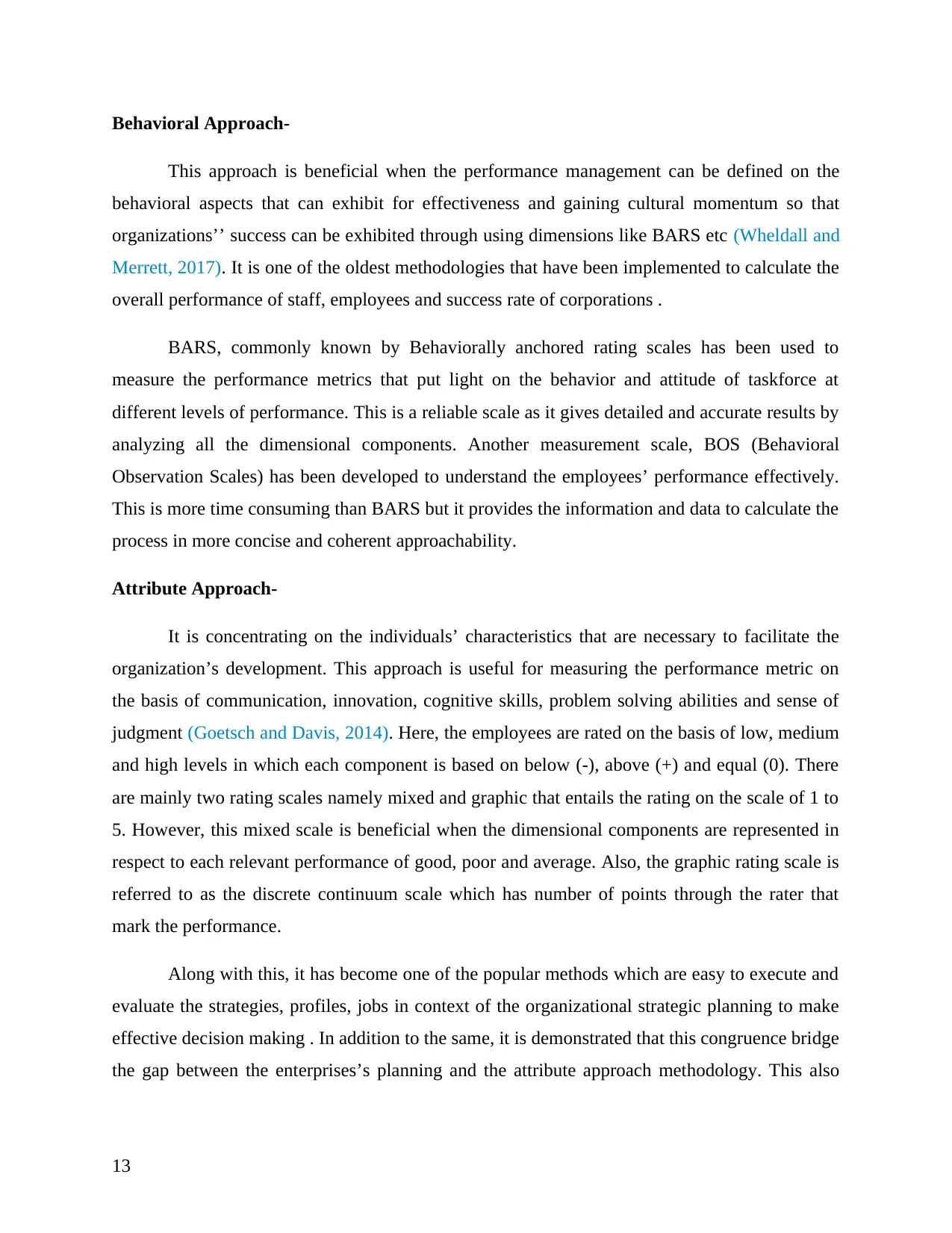
Behavioral Approach-
This approach is beneficial when the performance management can be defined on the
behavioral aspects that can exhibit for effectiveness and gaining cultural momentum so that
organizations’’ success can be exhibited through using dimensions like BARS etc (Wheldall and
Merrett, 2017). It is one of the oldest methodologies that have been implemented to calculate the
overall performance of staff, employees and success rate of corporations .
BARS, commonly known by Behaviorally anchored rating scales has been used to
measure the performance metrics that put light on the behavior and attitude of taskforce at
different levels of performance. This is a reliable scale as it gives detailed and accurate results by
analyzing all the dimensional components. Another measurement scale, BOS (Behavioral
Observation Scales) has been developed to understand the employees’ performance effectively.
This is more time consuming than BARS but it provides the information and data to calculate the
process in more concise and coherent approachability.
Attribute Approach-
It is concentrating on the individuals’ characteristics that are necessary to facilitate the
organization’s development. This approach is useful for measuring the performance metric on
the basis of communication, innovation, cognitive skills, problem solving abilities and sense of
judgment (Goetsch and Davis, 2014). Here, the employees are rated on the basis of low, medium
and high levels in which each component is based on below (-), above (+) and equal (0). There
are mainly two rating scales namely mixed and graphic that entails the rating on the scale of 1 to
5. However, this mixed scale is beneficial when the dimensional components are represented in
respect to each relevant performance of good, poor and average. Also, the graphic rating scale is
referred to as the discrete continuum scale which has number of points through the rater that
mark the performance.
Along with this, it has become one of the popular methods which are easy to execute and
evaluate the strategies, profiles, jobs in context of the organizational strategic planning to make
effective decision making . In addition to the same, it is demonstrated that this congruence bridge
the gap between the enterprises’s planning and the attribute approach methodology. This also
13
This approach is beneficial when the performance management can be defined on the
behavioral aspects that can exhibit for effectiveness and gaining cultural momentum so that
organizations’’ success can be exhibited through using dimensions like BARS etc (Wheldall and
Merrett, 2017). It is one of the oldest methodologies that have been implemented to calculate the
overall performance of staff, employees and success rate of corporations .
BARS, commonly known by Behaviorally anchored rating scales has been used to
measure the performance metrics that put light on the behavior and attitude of taskforce at
different levels of performance. This is a reliable scale as it gives detailed and accurate results by
analyzing all the dimensional components. Another measurement scale, BOS (Behavioral
Observation Scales) has been developed to understand the employees’ performance effectively.
This is more time consuming than BARS but it provides the information and data to calculate the
process in more concise and coherent approachability.
Attribute Approach-
It is concentrating on the individuals’ characteristics that are necessary to facilitate the
organization’s development. This approach is useful for measuring the performance metric on
the basis of communication, innovation, cognitive skills, problem solving abilities and sense of
judgment (Goetsch and Davis, 2014). Here, the employees are rated on the basis of low, medium
and high levels in which each component is based on below (-), above (+) and equal (0). There
are mainly two rating scales namely mixed and graphic that entails the rating on the scale of 1 to
5. However, this mixed scale is beneficial when the dimensional components are represented in
respect to each relevant performance of good, poor and average. Also, the graphic rating scale is
referred to as the discrete continuum scale which has number of points through the rater that
mark the performance.
Along with this, it has become one of the popular methods which are easy to execute and
evaluate the strategies, profiles, jobs in context of the organizational strategic planning to make
effective decision making . In addition to the same, it is demonstrated that this congruence bridge
the gap between the enterprises’s planning and the attribute approach methodology. This also
13
Paraphrase This Document
Need a fresh take? Get an instant paraphrase of this document with our AI Paraphraser
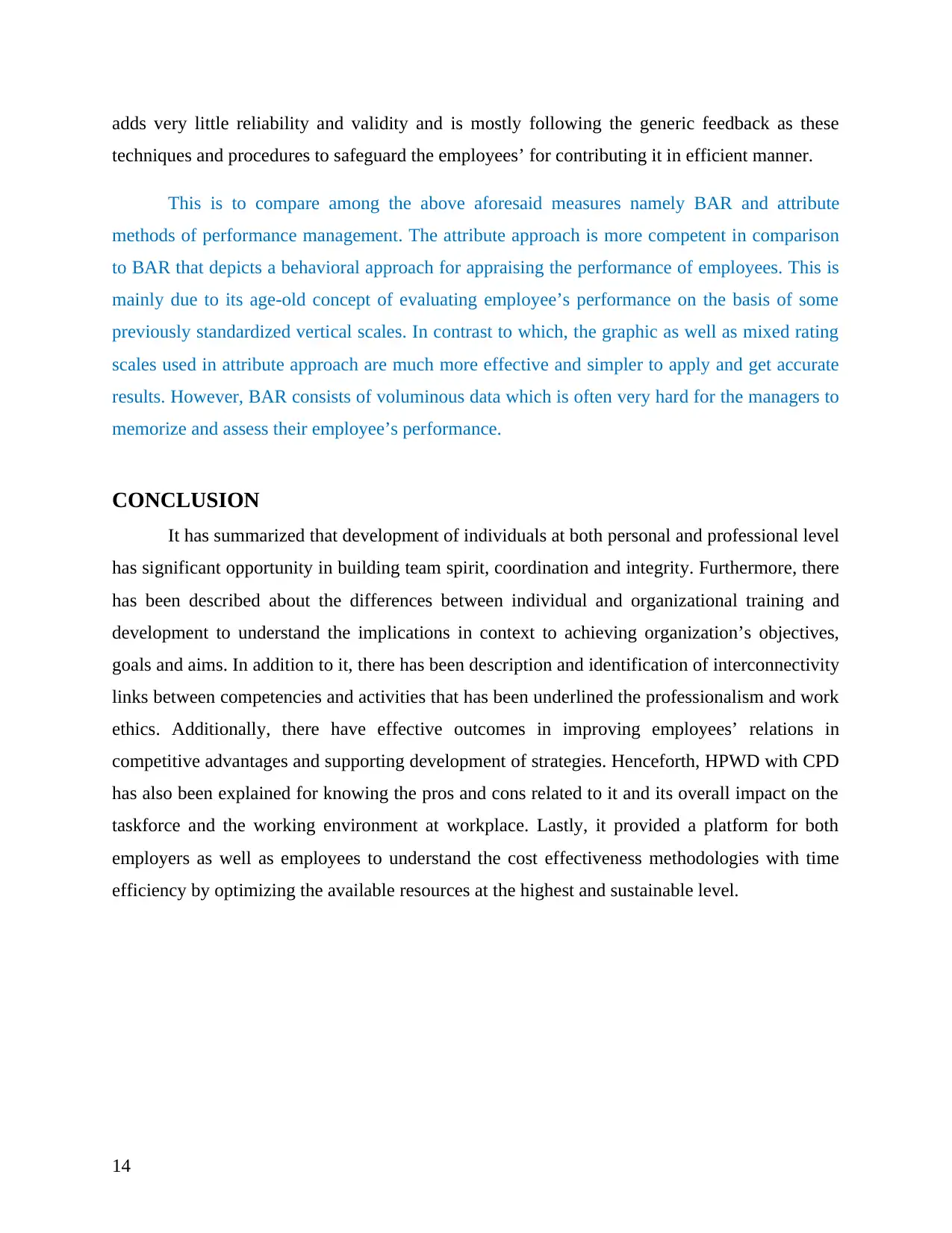
adds very little reliability and validity and is mostly following the generic feedback as these
techniques and procedures to safeguard the employees’ for contributing it in efficient manner.
This is to compare among the above aforesaid measures namely BAR and attribute
methods of performance management. The attribute approach is more competent in comparison
to BAR that depicts a behavioral approach for appraising the performance of employees. This is
mainly due to its age-old concept of evaluating employee’s performance on the basis of some
previously standardized vertical scales. In contrast to which, the graphic as well as mixed rating
scales used in attribute approach are much more effective and simpler to apply and get accurate
results. However, BAR consists of voluminous data which is often very hard for the managers to
memorize and assess their employee’s performance.
CONCLUSION
It has summarized that development of individuals at both personal and professional level
has significant opportunity in building team spirit, coordination and integrity. Furthermore, there
has been described about the differences between individual and organizational training and
development to understand the implications in context to achieving organization’s objectives,
goals and aims. In addition to it, there has been description and identification of interconnectivity
links between competencies and activities that has been underlined the professionalism and work
ethics. Additionally, there have effective outcomes in improving employees’ relations in
competitive advantages and supporting development of strategies. Henceforth, HPWD with CPD
has also been explained for knowing the pros and cons related to it and its overall impact on the
taskforce and the working environment at workplace. Lastly, it provided a platform for both
employers as well as employees to understand the cost effectiveness methodologies with time
efficiency by optimizing the available resources at the highest and sustainable level.
14
techniques and procedures to safeguard the employees’ for contributing it in efficient manner.
This is to compare among the above aforesaid measures namely BAR and attribute
methods of performance management. The attribute approach is more competent in comparison
to BAR that depicts a behavioral approach for appraising the performance of employees. This is
mainly due to its age-old concept of evaluating employee’s performance on the basis of some
previously standardized vertical scales. In contrast to which, the graphic as well as mixed rating
scales used in attribute approach are much more effective and simpler to apply and get accurate
results. However, BAR consists of voluminous data which is often very hard for the managers to
memorize and assess their employee’s performance.
CONCLUSION
It has summarized that development of individuals at both personal and professional level
has significant opportunity in building team spirit, coordination and integrity. Furthermore, there
has been described about the differences between individual and organizational training and
development to understand the implications in context to achieving organization’s objectives,
goals and aims. In addition to it, there has been description and identification of interconnectivity
links between competencies and activities that has been underlined the professionalism and work
ethics. Additionally, there have effective outcomes in improving employees’ relations in
competitive advantages and supporting development of strategies. Henceforth, HPWD with CPD
has also been explained for knowing the pros and cons related to it and its overall impact on the
taskforce and the working environment at workplace. Lastly, it provided a platform for both
employers as well as employees to understand the cost effectiveness methodologies with time
efficiency by optimizing the available resources at the highest and sustainable level.
14
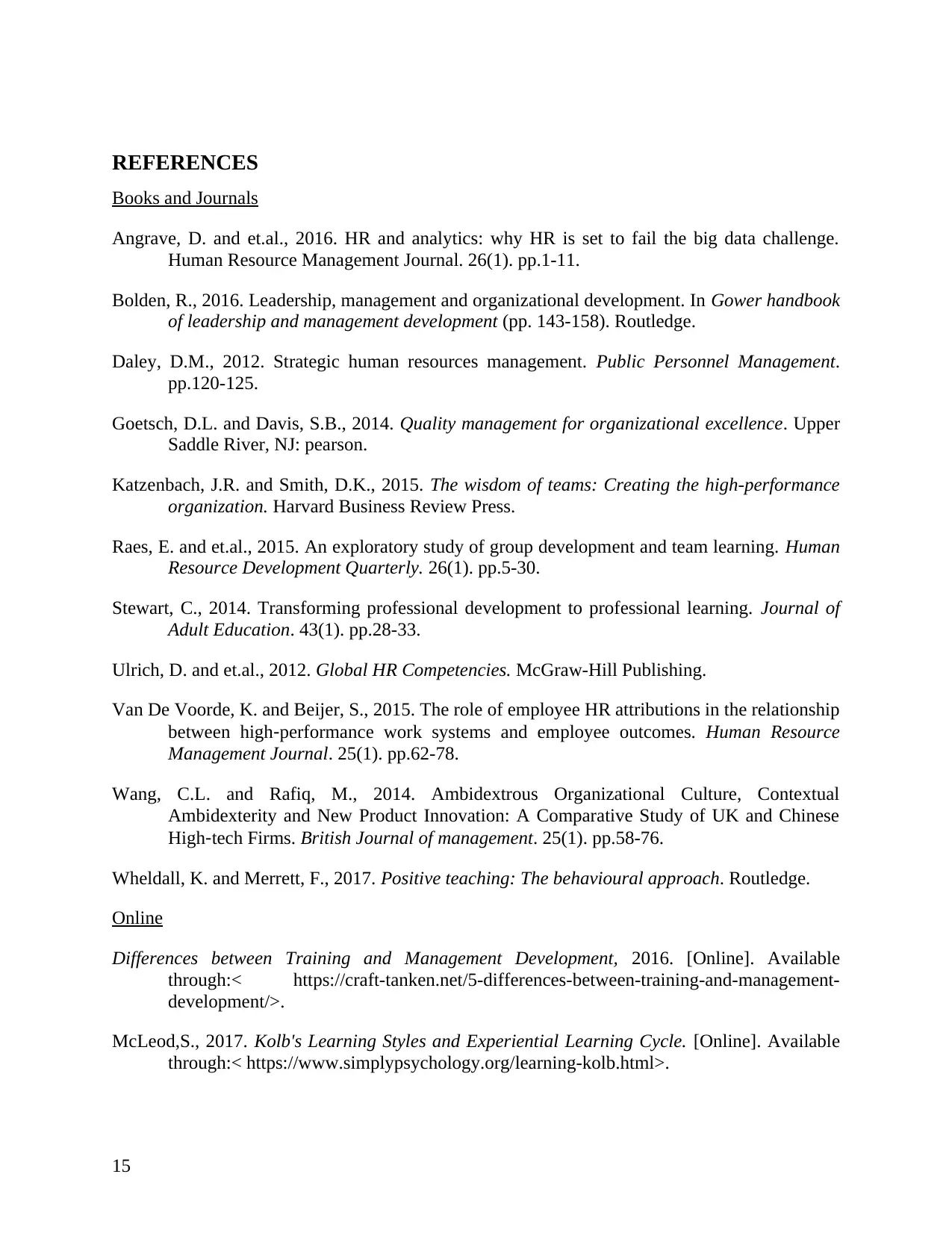
REFERENCES
Books and Journals
Angrave, D. and et.al., 2016. HR and analytics: why HR is set to fail the big data challenge.
Human Resource Management Journal. 26(1). pp.1-11.
Bolden, R., 2016. Leadership, management and organizational development. In Gower handbook
of leadership and management development (pp. 143-158). Routledge.
Daley, D.M., 2012. Strategic human resources management. Public Personnel Management.
pp.120-125.
Goetsch, D.L. and Davis, S.B., 2014. Quality management for organizational excellence. Upper
Saddle River, NJ: pearson.
Katzenbach, J.R. and Smith, D.K., 2015. The wisdom of teams: Creating the high-performance
organization. Harvard Business Review Press.
Raes, E. and et.al., 2015. An exploratory study of group development and team learning. Human
Resource Development Quarterly. 26(1). pp.5-30.
Stewart, C., 2014. Transforming professional development to professional learning. Journal of
Adult Education. 43(1). pp.28-33.
Ulrich, D. and et.al., 2012. Global HR Competencies. McGraw-Hill Publishing.
Van De Voorde, K. and Beijer, S., 2015. The role of employee HR attributions in the relationship
between high‐performance work systems and employee outcomes. Human Resource
Management Journal. 25(1). pp.62-78.
Wang, C.L. and Rafiq, M., 2014. Ambidextrous Organizational Culture, Contextual
Ambidexterity and New Product Innovation: A Comparative Study of UK and Chinese
High‐tech Firms. British Journal of management. 25(1). pp.58-76.
Wheldall, K. and Merrett, F., 2017. Positive teaching: The behavioural approach. Routledge.
Online
Differences between Training and Management Development, 2016. [Online]. Available
through:< https://craft-tanken.net/5-differences-between-training-and-management-
development/>.
McLeod,S., 2017. Kolb's Learning Styles and Experiential Learning Cycle. [Online]. Available
through:< https://www.simplypsychology.org/learning-kolb.html>.
15
Books and Journals
Angrave, D. and et.al., 2016. HR and analytics: why HR is set to fail the big data challenge.
Human Resource Management Journal. 26(1). pp.1-11.
Bolden, R., 2016. Leadership, management and organizational development. In Gower handbook
of leadership and management development (pp. 143-158). Routledge.
Daley, D.M., 2012. Strategic human resources management. Public Personnel Management.
pp.120-125.
Goetsch, D.L. and Davis, S.B., 2014. Quality management for organizational excellence. Upper
Saddle River, NJ: pearson.
Katzenbach, J.R. and Smith, D.K., 2015. The wisdom of teams: Creating the high-performance
organization. Harvard Business Review Press.
Raes, E. and et.al., 2015. An exploratory study of group development and team learning. Human
Resource Development Quarterly. 26(1). pp.5-30.
Stewart, C., 2014. Transforming professional development to professional learning. Journal of
Adult Education. 43(1). pp.28-33.
Ulrich, D. and et.al., 2012. Global HR Competencies. McGraw-Hill Publishing.
Van De Voorde, K. and Beijer, S., 2015. The role of employee HR attributions in the relationship
between high‐performance work systems and employee outcomes. Human Resource
Management Journal. 25(1). pp.62-78.
Wang, C.L. and Rafiq, M., 2014. Ambidextrous Organizational Culture, Contextual
Ambidexterity and New Product Innovation: A Comparative Study of UK and Chinese
High‐tech Firms. British Journal of management. 25(1). pp.58-76.
Wheldall, K. and Merrett, F., 2017. Positive teaching: The behavioural approach. Routledge.
Online
Differences between Training and Management Development, 2016. [Online]. Available
through:< https://craft-tanken.net/5-differences-between-training-and-management-
development/>.
McLeod,S., 2017. Kolb's Learning Styles and Experiential Learning Cycle. [Online]. Available
through:< https://www.simplypsychology.org/learning-kolb.html>.
15
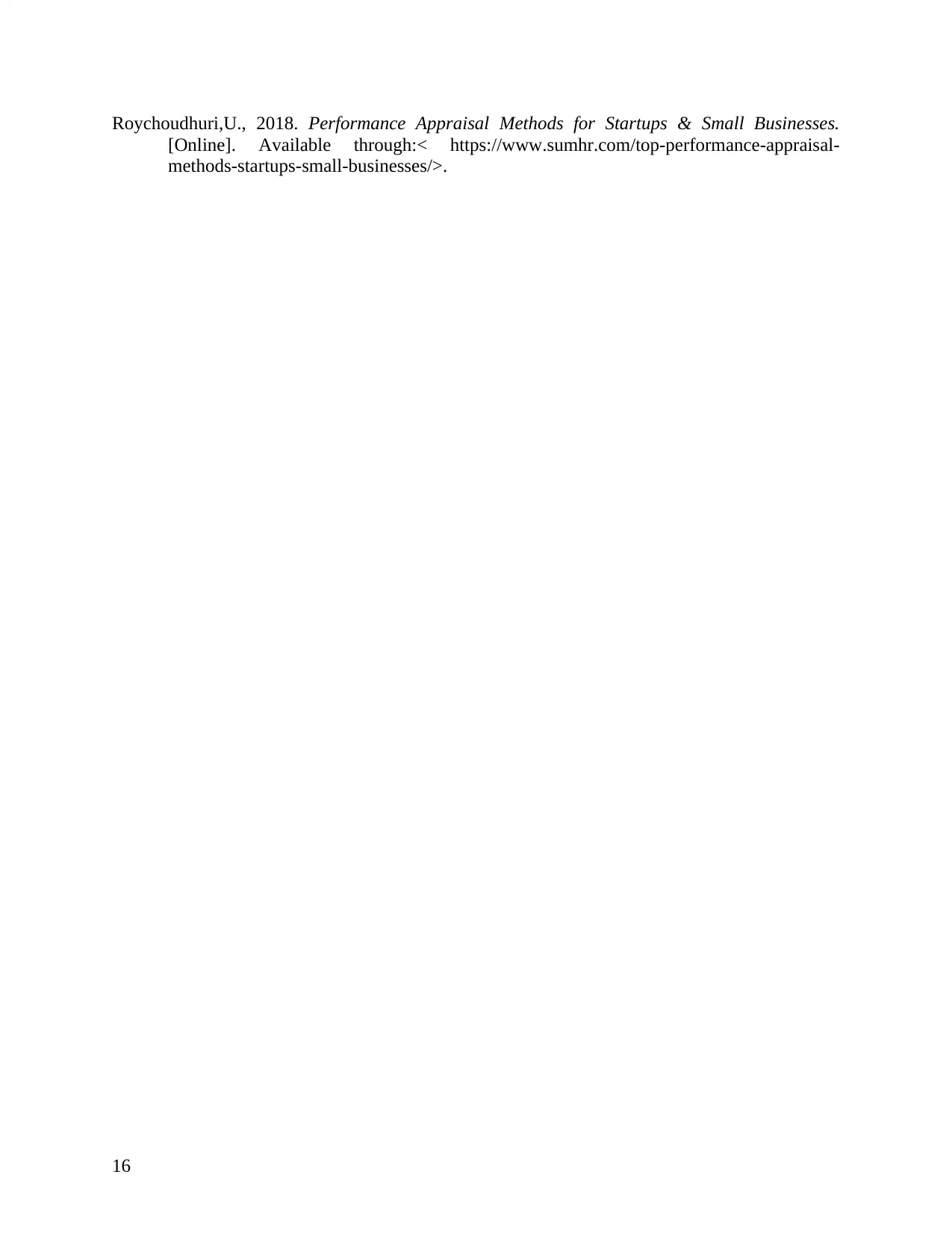
Roychoudhuri,U., 2018. Performance Appraisal Methods for Startups & Small Businesses.
[Online]. Available through:< https://www.sumhr.com/top-performance-appraisal-
methods-startups-small-businesses/>.
16
[Online]. Available through:< https://www.sumhr.com/top-performance-appraisal-
methods-startups-small-businesses/>.
16
1 out of 16
Related Documents
Your All-in-One AI-Powered Toolkit for Academic Success.
+13062052269
info@desklib.com
Available 24*7 on WhatsApp / Email
![[object Object]](/_next/static/media/star-bottom.7253800d.svg)
Unlock your academic potential
© 2024 | Zucol Services PVT LTD | All rights reserved.





